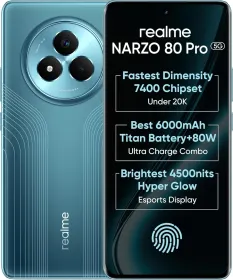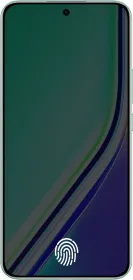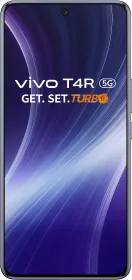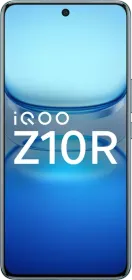TL; DR
- Among all the handsets, the realme Narzo 80 Pro and the Infinix Note 50s 5G have the slimmest profile of 7.6 mm.
- Although all the phones in the comparison have AMOLED screens that support a 120Hz refresh rate (except the vivo T4x, which has an IPS LCD screen), the realme Narzo 80 Pro has the brightest screen of all, both in high-brightness mode and in terms of local peak brightness.
- Unlike any other handset in the comparison, Samsung has promised to offer six years of Android updates with the Galaxy A26 5G. The Nothing Phone (3a) and the CMF Phone 2 Pro come in second with three years of promised operating system updates.
The CMF Phone 2 Pro seems to strike the right balance between affordability, usability, and a bit of DIY customization for those who are into it. However, the phone competes in a segment already flooded with models from various brands, including Oppo, realme, vivo, Poco, CMF’s parent brand, Nothing, Infinix, and Samsung. Every brand has its respective torchbearer in the segment, and most of them are doing well in the market.
In today’s comparison, we’ve compiled as much information as possible about what we believe are the eight most popular smartphones in this segment, to see how the CMF Phone 2 Pro compares to them. Spoiler alert: the capable chipset, a dedicated telephoto camera, and a customizable back plate do give it an edge.
Also Read: vivo T4 vs. Edge 60 Fusion vs. Phone (3a): Which Is The Right Mid-Ranger For You At Rs. 25,000?
CMF Phone 2 Pro vs. Competition: Key Specifications
| CMF Phone 2 Pro | Oppo K13 5G | realme Narzo 80 Pro | vivo T4x 5G | Poco X7 5G | Nothing Phone (3a) 5G | Infinix Note 50s 5G | Samsung Galaxy A26 5G | |
| Dimensions | 164 x 78 x 7.8 mm | 163.2 x 76.1 x 8.5 mm | 162.8 x 74.9 x 7.6 mm | 165.7 x 76.3 x 8.1 mm | 162.3 x 74.4 x 8.4 mm or 8.6 mm | 163.5 x 77.5 x 8.4 mm | 164.3 x 74.5 x 7.6 mm | 164 x 77.5 x 7.7 mm |
| Weight | 185 grams | 208 g | 179 g | 204 g or 208 g | 185.5 g or 190 g | 201 g | 180 g | 200 g |
| IP Rating, Durability | IP54 | IP65 | IP68/IP69; MIL-STD-810H | IP64, MIL-STD-810H | IP68/IP69 | IP64 | IP64, MIL-STD-810H | IP67 |
| Display | 6.77-inch AMOLED screen; 120 Hz, 1300 nits (HBM), 3000 nits (peak) | 6.67-inch AMOLED screen; 120Hz, 1200 nits (peak) | 6.72-inch OLED screen; 120Hz, 1400 nits (HBM), 4500 nits (peak) | 6.72-inch LCD screen; 120Hz, 1050 nits (HBM) | curved 6.67-inch AMOLED screen; 120Hz, 1200 nits (HBM), 3000 nits (peak) | 6.77-inch AMOLED screen; 120Hz, 1300 nits (HBM), 3000 nits (peak) | 6.78-inch AMOLED screen; 144Hz, 1300 nits (peak) | 6.7-inch Super AMOLED; 120Hz, 1000 nits (peak) |
| Fingerprint Scanner | Under-display optical sensor | Under-display optical sensor | Under-display optical sensor | Side-mounted | Under-display optical sensor | Under-display optical sensor | Under-display optical sensor | Side-mounted |
| Stereo Speakers | Yes | Yes | Yes | Yes | Yes | Yes | Yes | Yes, tuned by JBL |
| Resolution | 1080 x 2392 pixels | 1080 x 2400 pixels | 1080 x 2392 pixels | 1080 x 2408 pixels | 1220 x 2712 pixels | 1080 x 2392 pixels | 1080 x 2436 pixels | 1080 x 2340 pixels |
| Processor | MediaTek Dimensity 7300 Pro (4nm) | Qualcomm Snapdragon 6 Gen 4 (4 nm) 1100 + 3097 | Mediatek Dimensity 7400 (4 nm) 1050 + 2800 | Mediatek Dimensity 7300 (4nm) 1026 + 2932 | Mediatek Dimensity 7300 Ultra (4nm) 1040 + 2939 | Qualcomm Snapdragon 7s Gen 3 (4 nm) | Mediatek Dimensity 7300 Ultimate (4 nm) | Samsung Exynos 1380 SoC |
| RAM & Storage Type | LPDDR4X & UFS 2.2 | LPDDR4X & UFS 3.1 | LPDDR4X & UFS 3.1 | LPDDR4X & UFS 3.1 | LPDDR4X & UFS 2.2 | LPDDR4X & UFS 2.2 | LPDDR5X & UFS 2.2 | UFS 2.2 |
| Operating System | Nothing OS 3.2 (three major Android updates) | ColorOS 15 (two major Android updates) | Realme UI 6.0 (two major Android updates) | Funtouch OS 15 (two major Android updates) | HyperOS 2.0 (two more Android updates) | Nothing OS 3.1 (three major Android updates) | XOS 15 (two major Android updates) | One Ui 7.0 (six major Android updates) |
| Primary Camera | 50MP (f/1.88, EIS) | 50MP (f/1.9) | 50MP (f/1.8, OIS) | 50MP (f/1.8) | 50MP (f/1.5, OIS) | 50MP (f/1.9, OIS) | 64MP (f/1.8) | 50MP (f/1.8, OIS) |
| Secondary Camera | 8MP (f/2.2) ultrawide | 2MP (f/2.4) depth | 2MP (f/2.4) depth | 2MP (f/2.4) depth | 8MP (f/2.2) ultrawide | 8MP (f/2.2) ultrawide | 2MP | 2MP (f/2.4) macro |
| Tertiary Camera | 50MP (f/1.85) 2x telephoto | – | – | – | 2MP (f/2.4) macro | 50MP (f/2.0) 2x telephoto | – | – |
| Selfie Camera | 16MP (f/2.45) | 16MP (f/2.5) | 16MP (f/2.4) | 8MP (f/2.1) | 20MP (f/2.2) | 32MP (f/2.2) | 13MP (f/2.2) | 13MP (f/2.2) |
| Connectivity | 5G, dual 4G VoLTE, Wi-Fi 6, Bluetooth v5.3, GPS, USB-Type C | 5G, 4G, Wi-Fi 6, Bluetooth v5.2, GPS, USB-Type C | 5G, 4G, Wi-Fi dual-band, Bluetooth v5.4, GPS, USB Type-C | 5G, 4G, Wi-Fi 6, Bluetooth v5.4, GPS, USB Type-C | 5G, 4G, Wi-Fi 6, Bluetooth v5.4, GPS, USB Type-C | 5G, 4G, Wi-Fi 6, Bluetooth v5.4, GPS, USB Type-C | 5G, 4G, Wi-Fi 6, Bluetooth v5.4, GPS, USB Type-C | 5G, 4G, Wi-Fi dual-band, Bluetooth v5.3, GPS, USB Type-C |
| NFC | – | – | – | – | Yes | Yes | – | – |
| IR Blaster | – | Yes | – | Yes | Yes | – | Yes | – |
| Battery Capacity | 5,000 mAh | 7,000 mAh Si/C | 6,000 mAh Si/C | 6,500 mAh | 5,500 mAh | 5,000 mAh | 5,500 mAh | 5,000 mAh |
| Charging Speed | 33W | 80W | 80W | 44W | 45W | 50W | 45W | 25W |
| Charge In The Box | Yes | Yes | Yes | Yes | Yes | No | Yes | No |
Also Read: Oppo K13 5G vs. Infinix Note 50s 5G+: Which Offers More Value For Your Money Under Rs. 20,000?
CMF Phone 2 Pro vs. Competition: Key Takeaways



- Among all the handsets, the realme Narzo 80 Pro and the Infinix Note 50s 5G have the slimmest profile of 7.6 mm.
- Further, the realme Narzo 80 Pro weighs 179 grams, making it the lightest phone in the comparison. Coming in second is the Infinix Note 50s (180 grams), while the CMF Phone 2 Pro comes third (weighs 185 grams).
- The realme Narzo 80 Pro and the Poco X7 5G (review) are both IP68/IP69 rated for dust and water resistance.
- Although all the phones in the comparison have AMOLED screens that support a 120Hz refresh rate (except the vivo T4x, which has an IPS LCD screen), the realme Narzo 80 Pro has the brightest screen of all, both in high-brightness mode and in terms of local peak brightness.
- Although all the phones have an under-display fingerprint scanner, the vivo T4x and the Galaxy A26 5G (review) have a side-mounted sensor.
- Regarding raw benchmarks, the Snapdragon 7s Gen 3 (4nm) on the Nothing Phone (3a) leads the pack. However, other phones offer faster storage (UFS 3.1), like the Oppo K13 5G, the Narzo 80 Pro, and the vivo T4x. With the Dimensity 7300 chip, the CMF Phone 1 (review) was capable of 120 fps BGMI gameplay, and the CMF Phone 2 Pro should be similarly capable.
Also Read: iQOO Z10x vs. realme P3x: Which Entry-Level 5G Handset Is Better For You?
- Unlike any other handset in the comparison, Samsung has promised to offer six years of Android updates with the Galaxy A26 5G. The Nothing Phone (3a) and the CMF Phone 2 Pro come in second with three years of promised operating system updates.
- Although a 50MP primary camera seems standard in the segment, it is the Infinix Note 50s that stands out with a 64MP (f/1.8) primary sensor. Three of the eight phones feature a secondary ultrawide camera: the CMF Phone 2 Pro, Poco X7 5G, and the Phone (3a 5G). Last but not least, Nothing and its sub-brand also provide a 2x optical zoom lens on their handsets.
- If you’re looking for a smartphone that lasts longer than other models in battery life, it’s the Oppo K13 5G (review). With a 7,000 mAh Si/C battery, the phone should provide the longest usage time between charges. It also supports 80W wired charging speed, which is the highest in the segment (shared with the realme Narzo 80 Pro).
- It’s worth mentioning that the Nothing Phone (3a) and the Galaxy A26 5G do not ship with a charger in the box.
Also Read: Infinix Note 50X vs. Samsung Galaxy F16: Best 5G Phone Under Rs 12,000
CMF Phone 2 Pro vs. Competition: Starting Price
| CMF Phone 2 Pro | Oppo K13 5G | realme Narzo 80 Pro | vivo T4x 5G | Poco X7 5G | Nothing Phone (3a) 5G | Infinix Note 50s 5G | Samsung Galaxy A26 5G | |
| 8GB + 128GB | Rs. 18,999 | Rs. 17,999 | Rs. 18,999 | Rs. 14,999 | Rs. 17,999 | Rs. 24,999 | Rs. 15,999 | Rs. 24,999 |
| 8GB + 256GB | Rs. 20,999 | Rs. 19,999 | Rs. 20,499 | Rs. 16,999 | Rs. 19,999 | Rs. 26,999 | Rs. 17,999 | Rs. 27,999 |
| 12GB + 256GB | – | – | Rs. 22,499 | |||||
| Buy Now | Buy Now | Buy Now | Buy Now | Buy Now | Buy Now | Buy Now | Buy Now |
CMF Phone 2 Pro vs. Competition: Conclusion
- The CMF Phone 2 Pro offers a bright screen, a capable processor, and three years of major Android updates. Further, the triple-rear camera setup sets the phone apart in the segment. Last but not least, you can remove the phone’s back plate and swap it with another one (you can also attach several accessories to the handset’s back panel).
- The Oppo K13 5G handset offers the largest battery in the segment — 7,000 mAh — with support for 80W wired charging. Even otherwise, it offers a decent set of specifications, including a capable Snapdragon 6 Gen 4 SoC and UFS 3.1 storage.
- There are plenty of reasons to purchase the realme Narzo 80 Pro, including the bright OLED screen, the Dimensity 7400 SoC, UFS 3.1 storage, and a 6,000 mAh battery that supports 80W fast charging (one of the fastest in the segment).
- The vivo T4x stands out for its affordability, as the baseline variant with 8GB of RAM and 128GB of storage costs only Rs. 15,000. The handset features the Dimensity 7300 processor, typically found in more expensive models, and a 6,500 mAh battery that supports 44W charging.
Also Read: Galaxy Tab S10FE vs. iPad 11th Gen (2025): Which Is The Better Tablet For You?
- You can get the Poco X7 5G for its curved, bright screen, HyperOS 2.0 operating system, and 50MP primary camera.
- The Nothing Phone (3a) is the most expensive handset in the comparison. We know it isn’t the CMF Phone 2 Pro’s direct competition, but since it’s a part of the same ideology (of making smartphones fun again), we had to include the phone in the list. Among the handset’s pros are a bright screen, a capable chipset, three years of promised Android upgrades, and a triple-rear camera setup.
- The Infinix Note 50s 5G offers a 64MP primary camera, an RGB Halo light on the back panel, a 144Hz AMOLED screen, and a 5,500 mAh battery.
- Last but not least, the Galaxy A26 5G is for buyers who want longevity from their smartphone. Although its specifications aren’t exceptional, the six years of software support remain unmatched in the segment.
You can follow Smartprix on Twitter, Facebook, Instagram, and Google News. Visit smartprix.com for the latest tech and auto news, reviews, and guides.

































